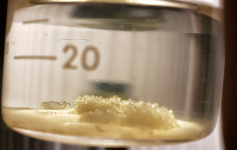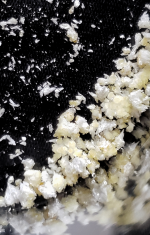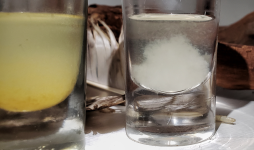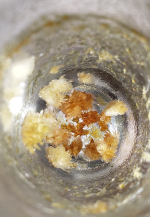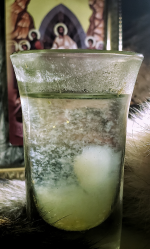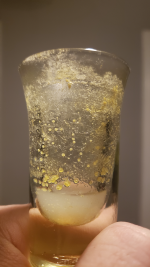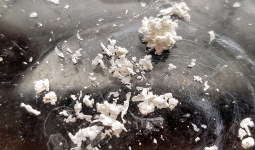Samvidbuho
Rising Star
I've run into difficulties which I can't remedy nor explain, and I've very much like someone to help elucidate what is going on.
Background:
I had posted a couple recrystallizations from the same sample material on the "just some xtals" thread. Originally a re-x was performed on a combination of leftovers from old reactions (M. hostilis). The first re-x produced two different types of crystals differing in both appearance and color - a white set, and an amber set. I separated the white crystals from the amber ones, and recrystallized both separately using the same solvent I used previously, heptane.
The glass containing the amber crystals produced a fine end result, but the glass with the white crystals had a troublesome re-x. I changed nothing in the procedure, but upon transferring the solution of dissolved white crystals into the shotglass for re-x there was immediate precipitation, but of a different sort than I have encountered before. There were many particulates, all of which formed a nebulous dense network in a state of constant suspension. After 72 hours not a single crystal had formed anywhere, and eventually as all the solvent which had formed a top layer evaporated off the remaining suspension of particulates just slowly contracted more and more until in the end they a very thin layer of translucent white was left behind. The sparse crystals that did form manifested as small rectangular prisms, representing a new crystal form in this series of experiments.
So the problem here was no crystal formation in the way I expected.
Current Problems (Old Problems Persist):
Since this is batch I reserved for R&D purposes, I decided to recrystallize everything again, separately, hoping to purify further and get better crystals. So I start with the colored crystals and the [formerly] white crystals, like before.
Colored crystals:
There were immediate differences in getting all the crystals into solution. I used hot heptane for the third time, but here I had to continuously add more and more just to try and dissolve more crystals. After adding what should have been way more than sufficient solvent, I decided to just separate the solution from the insoluble material and reduce the volume until it was super-saturated. Yet, precipitate had already begun to develop, even at 4x the heptane I had used previously. Not wanting to over-saturate, I transferred this into a shot glass which just barely ended up containing everything.
But the same thing happened --while side crystals were simultaneously developing, here again was this suspension of particles which had amassed and which sunk to the bottom.
I tried seeding with a decent size crystal (which just pushed up a corresponding volume of suspended material, as shown in the picture below) but this just accomplished causing some minor crashing from the solution above the suspension. I even tried putting this on a Fischer vibration machine, sort of sonicating it. This made the cloud a little less opaque, but certainly didn't resolve anything.
White crystals: Same problem of suspension of particles which don't crystallize, and poor final product.
I might see how the more recrystallizations happen, the more each component compound gets separated out, changing the solubilities.. maybe the cloud was another compound than N,N-DMT? Although to me it seems unlikely, as heptane is pretty selective for that. But I still can't understand why the larger volume of solvent was needed to dissolve the crystals (insufficiently too), and why what I thought should have been a nice end product turned out to be underwhelming, especially since I didn't change anything up.
Any advice?
A thank you in advance.
Picture descriptions:
[1] Typical environment for re-x
[2] The separated white crystals from the original recrystallization
[3] First re-x of separated white crystals [right shotglass], showing the suspension of particles, and compared to first re-x of the amber crystals [left shotglass] (freshly set, normal super-saturation behavior)
[4] End product of the amber re-x
[5] The poor end product of the white re-x
[6] Re(-re)-x on the product shown in image 4, with the colored crystals, showing this cloud-mass.
[7] Where [6] is at currently, showing really not the greatest results
Background:
I had posted a couple recrystallizations from the same sample material on the "just some xtals" thread. Originally a re-x was performed on a combination of leftovers from old reactions (M. hostilis). The first re-x produced two different types of crystals differing in both appearance and color - a white set, and an amber set. I separated the white crystals from the amber ones, and recrystallized both separately using the same solvent I used previously, heptane.
The glass containing the amber crystals produced a fine end result, but the glass with the white crystals had a troublesome re-x. I changed nothing in the procedure, but upon transferring the solution of dissolved white crystals into the shotglass for re-x there was immediate precipitation, but of a different sort than I have encountered before. There were many particulates, all of which formed a nebulous dense network in a state of constant suspension. After 72 hours not a single crystal had formed anywhere, and eventually as all the solvent which had formed a top layer evaporated off the remaining suspension of particulates just slowly contracted more and more until in the end they a very thin layer of translucent white was left behind. The sparse crystals that did form manifested as small rectangular prisms, representing a new crystal form in this series of experiments.
So the problem here was no crystal formation in the way I expected.
Current Problems (Old Problems Persist):
Since this is batch I reserved for R&D purposes, I decided to recrystallize everything again, separately, hoping to purify further and get better crystals. So I start with the colored crystals and the [formerly] white crystals, like before.
Colored crystals:
There were immediate differences in getting all the crystals into solution. I used hot heptane for the third time, but here I had to continuously add more and more just to try and dissolve more crystals. After adding what should have been way more than sufficient solvent, I decided to just separate the solution from the insoluble material and reduce the volume until it was super-saturated. Yet, precipitate had already begun to develop, even at 4x the heptane I had used previously. Not wanting to over-saturate, I transferred this into a shot glass which just barely ended up containing everything.
But the same thing happened --while side crystals were simultaneously developing, here again was this suspension of particles which had amassed and which sunk to the bottom.
I tried seeding with a decent size crystal (which just pushed up a corresponding volume of suspended material, as shown in the picture below) but this just accomplished causing some minor crashing from the solution above the suspension. I even tried putting this on a Fischer vibration machine, sort of sonicating it. This made the cloud a little less opaque, but certainly didn't resolve anything.
White crystals: Same problem of suspension of particles which don't crystallize, and poor final product.
I might see how the more recrystallizations happen, the more each component compound gets separated out, changing the solubilities.. maybe the cloud was another compound than N,N-DMT? Although to me it seems unlikely, as heptane is pretty selective for that. But I still can't understand why the larger volume of solvent was needed to dissolve the crystals (insufficiently too), and why what I thought should have been a nice end product turned out to be underwhelming, especially since I didn't change anything up.
Any advice?
A thank you in advance.
Picture descriptions:
[1] Typical environment for re-x
[2] The separated white crystals from the original recrystallization
[3] First re-x of separated white crystals [right shotglass], showing the suspension of particles, and compared to first re-x of the amber crystals [left shotglass] (freshly set, normal super-saturation behavior)
[4] End product of the amber re-x
[5] The poor end product of the white re-x
[6] Re(-re)-x on the product shown in image 4, with the colored crystals, showing this cloud-mass.
[7] Where [6] is at currently, showing really not the greatest results

